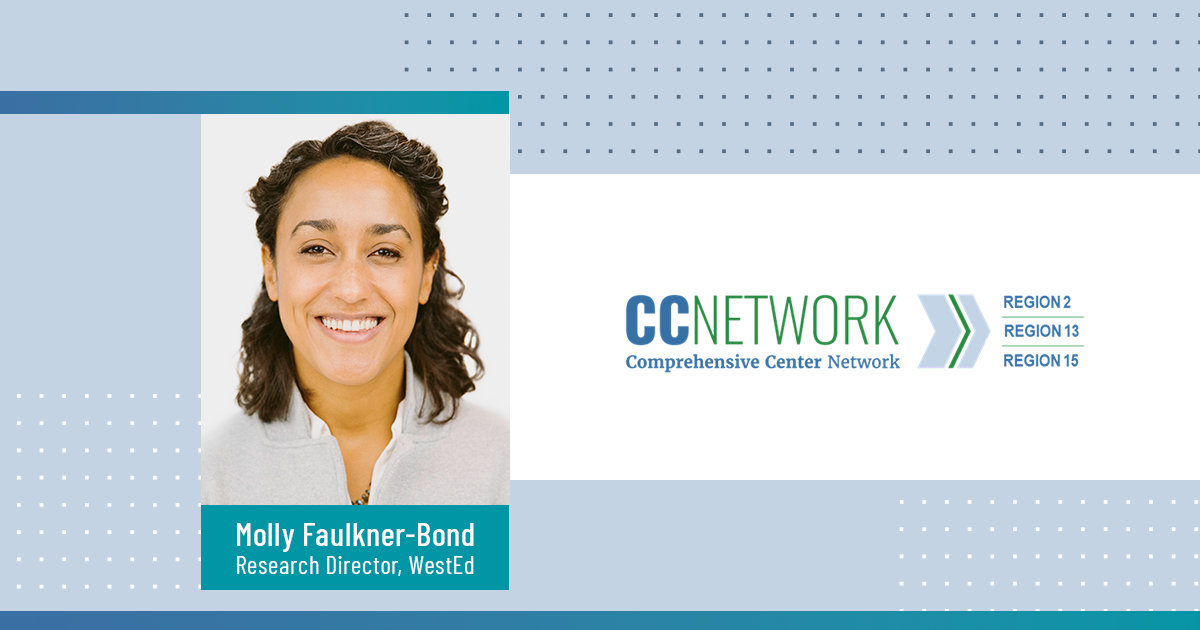A Logic Model for Systemic English Learner Reform: Insights From Molly Faulkner-Bond
Posted on

This year marks the 50th anniversary of the landmark Supreme Court decision Lau v. Nichols, which affirmed English Learners’ Constitutional right to receive an equal education. In honor of this milestone, Regional Comprehensive Centers 2, 13, and 15’s special blog series reports on emerging state and district systemic trends to improve education for English Learners, arising from the Centers’ work with state and local educational agencies and research partners. The series highlights relevant research and systemic implementation tools now widely available, and describes how focusing on English Learners in K–12 decisions may benefit all students.
To build effective and equitable English Learner supports and services across entire states, where should system-level leaders start? And where are they actually starting?
Molly Faulkner-Bond with the Region 15 Comprehensive Center addresses these and other questions in this blog post, the first in a series focusing on how states are working to improve outcomes for English Learners. Faulkner-Bond is also research director for English Learners and Migrant Education Services at WestEd.
Focusing on the Strengths and Needs of All Learners
It turns out that thinking in terms of “supports” and “services” may be the first mistake, she notes.
Faulkner-Bond suggests that state and district leaders zoom out in order to
- incorporate English Learner needs and assets into system design,
- coherently align systems, and
- root decision making at all levels in evolving research and evidence of student progress.
The overall lens matters. According to Faulkner-Bond, the lens through which system reform is viewed—a subject that REL West explores in Systemic Factors That Shape Multilingual Learners’ Educational Opportunities and Outcomes—is paramount:
“First, whether we are looking at systems change, or classroom change, it matters how we position this work.
“Here is what I mean: The traditional K–12 orientation in this country around ‘monolingualism’ has disadvantaged non-English native speakers. It has positioned them as having a deficit that needs to be overcome.
“In fact, anyone on the journey toward being bilingual is, in actuality, developing a major competitive advantage over their peers in this global economy and modern, interconnected world.
“And so, it is not helpful to frame this work as being ‘English Learners’ versus other students. In reality, most classrooms with English Learners are mixed.
“By broadening and deepening lesson planning and trajectory planning to include what we know multilingual students need and bring to the table, we open up new space to learn for all students.
“When the level of discussion, processing, critical thinking, and so on in any given classroom rises, everyone in the room, multilingual or not, stands to benefit.
“So, the opportunity is, instead of focusing on the ‘average’ output of ‘systems,’ to focus on the actual strengths and needs all kids bring into systems.
She adds, “Research tells us that walking into school with the ability to speak and think and interact in multiple languages is all the more reason why a student should, could, and would become high achieving, when surrounded by effective systems.”
“By broadening and deepening lesson planning and trajectory planning to include what we know multilingual students need and bring to the table, we open up new space to learn for all students.
The question then becomes, what is the logic model to strive for, based on the best of what the field currently knows?
Faulkner-Bond suggests leaders start by cohering disparate existing system components, then tethering them to continuous improvement cycles driven by evidence of English Learners realities on the ground.
“We think through how states can go further than just complying with what the law says—for example, around programs, assessments, and accountability—to use their afforded discretion to coherently tie these components together and calibrate them to real student needs and assets.
“It’s ‘How does the principal—and district leader and state leader—align systems at all levels and across all levels to actual evidence-based needs?’ including what they bring forward, what they need, what they are already currently getting, whether they are in the right settings. This is what we mean by an ‘ecological approach.’”
Bridging Systems With Evidence-Based Needs
The good news is that opportunities to align systems at all levels to evidence-based needs are arising across the nation, crystallizing, for example, in two ways that WestEd’s Comprehensive Centers will explore in this series:
- Certain “longitudinal levers” are shown by research to impact English Learner trajectories over time. An arc of interwoven experiences over many years affects when and how a child learns a second language. The field has an opportunity to expand on what works along that path and prevent early roadblocks.
- Coherent oral opportunities to learn. Students need all systems—including instruction, curriculum, and teacher development—and all subjects (like math, science, and social studies) oriented around providing them with meaningful classroom opportunities to simultaneously learn English, other content, and critical thinking without falling behind.
Current and Upcoming Posts in This Special Series
- Q&A With the Expert: Molly Faulkner-Bond on A Logic Model for Systemic English Learner Reform
- A Coherent Vision in California, Rhode Island, Connecticut: State-Level Multilingual Learner Frameworks
- Longitudinal Levers for English Learners (Part I): Dual Language, Extra Instructional Time, Counselors, Teacher Preparation
- Longitudinal Levers for English Learners (Part II): California Launches New Tool to Guide EL Reclassification Based on Language Use in the Classroom
- Longitudinal Levers for English Learners (Part III): New Mexico Adopts English Learner Disability Identification Guide
- Two Key Ways States Can Begin to Re-Orient K–12 Systems to Provide Students Essential Oral Opportunities to Learn
The contents of this post were developed by the Region 15 Comprehensive Center. The Region 15 Comprehensive Center is funded by a grant from the U.S. Department of Education. However, the contents of this post do not necessarily represent the policy of the Department of Education, and you should not assume endorsement by the federal government.
